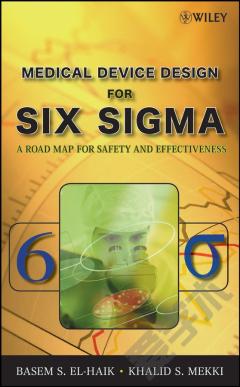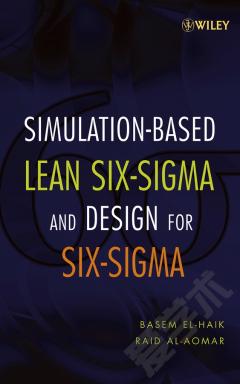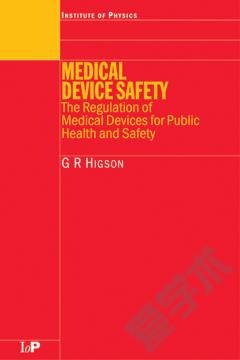Medical Device Design for Six Sigma —— A Road Map for Safety and Effectiveness
----- 医疗设备的六西格玛设计:安全与有效指导
Foreword. Preface. 1 Medical Device Design Quality. 1.1 Introduction. 1.2 The Essence of Quality. 1.3 Quality Operating System and the Device Life Cycle. 1.4 Evolution of Quality. 1.5 Business Excellence: A Value Proposition. 1.6 Summary. 2 Design for Six Sigma and Medical Device Regulation. 2.1 Introduction. 2.2 Global Perspective on Medical Device Regulations. 2.3 Medical Device Classifi cation. 2.4 Medical Device Safety. 2.5 Medical Device Quality Management Systems Requirements. 2.6 Medical Device Regulation Throughout the Product Development Life Cycle. 2.7 Summary. 3 Basic Statistics. 3.1 Introduction. 3.2 Common Probability Distributions. 3.3 Methods of Input and Output Analysis. 3.4 Descriptive Statistics. 3.5 Inferential Statistics. 3.6 Normal Distribution and Normality Assumption. 3.7 Summary. 4 The Six Sigma Process. 4.1 Introduction. 4.2 Six Sigma Fundamentals. 4.3 Process Modeling. 4.4 Business Process Management. 4.5 Measurement Systems Analysis. 4.6 Process Capability and Six Sigma Process Performance. 4.7 Overview of Six Sigma Improvement. 4.8 Six Sigma Gose Upstream: Design for Six Sigma. 4.9 Summary. Appendix 4A: Cause-and-Effect Tools. 5 Medical Device Design for Six Sigma. 5.1 Introduction. 5.2 Value of Designing for Six Sigma. 5.3 Medical Device DFSS Fundamentals. 5.4 The ICOV Process in Design. 5.5 The ICOV Process in Product Development. 5.6 Summary. 6 Medical Device DFSS Deployment. 6.1 Introduction. 6.2 Medical Device DFSS Deployment Fundamentals. 6.3 Predeployment Phase. 6.4 Deployment Phase. 6.5 Postdeployment Phase. 6.6 DFSS Sustainability Factors. 6.7 Black Belts and the DFSS Team: Cultural Change. 6.8 Summary. 7 Medical Device DFSS Project Road Map. 7.1 Introduction. 7.2 Medical Device DFSS Team. 7.3 Medical Device DFSS Road Map. 7.4 Software DFSS ICOV Process. 7.5 Summary. 8 Quality Function Deployment. 8.1 Introduction. 8.2 History of QFD. 8.3 QFD Fundamentals. 8.4 QFD Methodology. 8.5 HQQ Evaluation. 8.6 HQQ 1: The Customer's House. 8.7 HQQ 2: Translation House. 8.8 HQQ 3: Design House. 8.9 HQQ 4: Process House. 8.10 Application: Auto 3D. 8.11 Summary. 9 DFSS Axiomatic Design Method. 9.1 Introduction. 9.2 Axiomatic Method Fundamentals. 9.3 Introduction to Axiom 1. 9.4 Introduction to Axiom 2. 9.5 Axiomatic Design Theorems and Corollaries. 9.6 Application: Medication Mixing Machine. 9.7 Application: Axiomatic Design Applied to Design Controls. 9.8 Summary. Appendix 9A: Matrix Review. 10 DFSS Innovation for Medical Devices. 10.1 Introduction. 10.2 History of the Theory of Inventive Problem Solving. 10.3 TRIZ Fundamentals. 10.4 TRIZ Problem-Solving Process. 10.5 Ideal Final Result. 10.6 Building Suffi cient Functions. 10.7 Eliminating Harmful Functions. 10.8 Inventive Principles. 10.9 Detection and Measurement Concepts. 10.10 TRIZ Root Cause Analysis. 10.11 Evolution trends in Technological Systems. 10.12 TRIZ Functional Analysis and Analogy. 10.13 Application: Using Triads to Predict and Conceive Next-Generation Products. 10.14 Summary. Appendix 10A: Contradiction Matrix. 11 DFSS Risk Management Process. 11.1 Introduction. 11.2 Planning for Risk Management Activities in Design and Development. 11.3 Risk Assessment Techniques. 11.4 Risk Evaluation. 11.5 Risk Control. 11.6 Postproduction Control. 11.7 Summary. Appendix 11A: Robust Design Failure Mode and Effects Analysis. 11A.1 Parameter Diagram. 11A.2 Robust Design FMEA Elements. 12 Medical Device Design for X. 12.1 Introduction. 12.2 Design for Reliability. 12.3 Design for Packaging. 12.4 Design for Manufacture and Design for Assembly. 12.5 Design for Maintainability. 12.6 Design for Serviceability. 12.7 Summary. 13 DFSS Transfer Function and Scorecards. 13.1 Introduction. 13.2 Design Mapping. 13.3 Design Scorecards and the Transfer Function. 13.4 Transfer Function Mathematics. 13.5 Transfer Function and Optimization. 13.6 Monte Carlo Simulation. 13.7 Summary. 14 Fundamentals of Experimental Design. 14.1 Introduction. 14.2 Classical Design of Experiments. 14.3 Factorial Experiment. 14.4 Analysis of Variance. 14.5 2 k Full Factorial Designs. 14.6 Fractional Factorial Designs. 14.7 Other Factorial Designs. 14.8 Summary. Appendix 14A. 14A.1 Diagnostic Plots of Residuals. 14A.2 Pareto Chart of Effects. 14A.3 Square and Cube Plots. 14A.4 Interaction Plots. 15 Robust Parameter Design for Medical Devices. 15.1 Introduction. 15.2 Robust Design Fundamentals. 15.3 Robust Design Concepts. 15.4 Application: Dynamic Formulation. 15.5 Summary. 16 Medical Device Tolerance Design. 16.1 Introduction. 16.2 Tolerance Design and DFSS. 16.3 Worst-Case Tolerance. 16.4 Statistical Tolerances. 16.5 Taguchi's Loss Function and Safety Tolerance Design. 16.6 High- vs. Low-Level Requirements' Tolerance Relationships. 16.7 Taguchi's Tolerance Design Experiment. 16.8 Summary. 17 Medical Device DFSS Verifi cation and Validation. 17.1 Introduction. 17.2 Design Verifi cation Process. 17.3 Production Process Validation. 17.4 Software Validation. 17.5 Design Validation. 17.6 Summary. 18 DFSS Design Transfer. 18.1 Introduction. 18.2 Design Transfer Planning. 18.3 Process Control Plan. 18.4 Statistical Process Control. 18.5 Process Capability. 18.6 Advanced Product Quality Planning. 18.7 Device Master Record. 18.8 Summary. 19 Design Change Control, Design Review, and Design History File. 19.1 Introduction. 19.2 Design Change Control Process. 19.3 Design Review. 19.4 Design History File. 19.5 Summary. 20 Medical Device DFSS Case Study. 20.1 Introduction. 20.2 DFSS Identify Phase. 20.3 DFSS Characterize Phase. 20.4 DFSS Optimize Phase. 20.5 DFSS Verify/Validate Phase. 20.6 Summary. Glossary: DFSS Terminology. Appendix: Statistical Tables. References. Index.
{{comment.content}}








 京公网安备 11010802027623号
京公网安备 11010802027623号